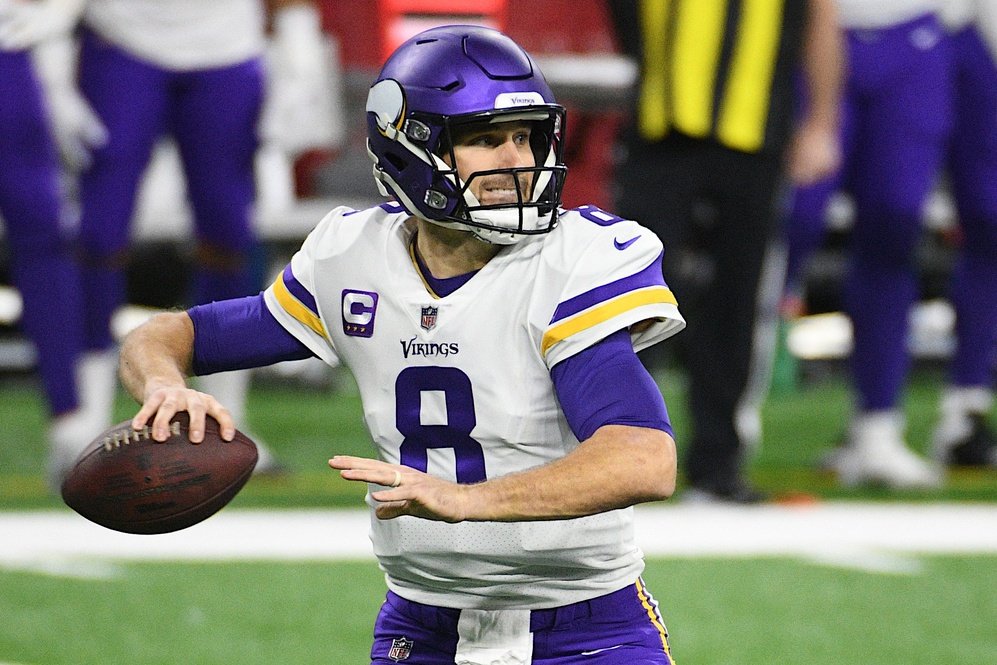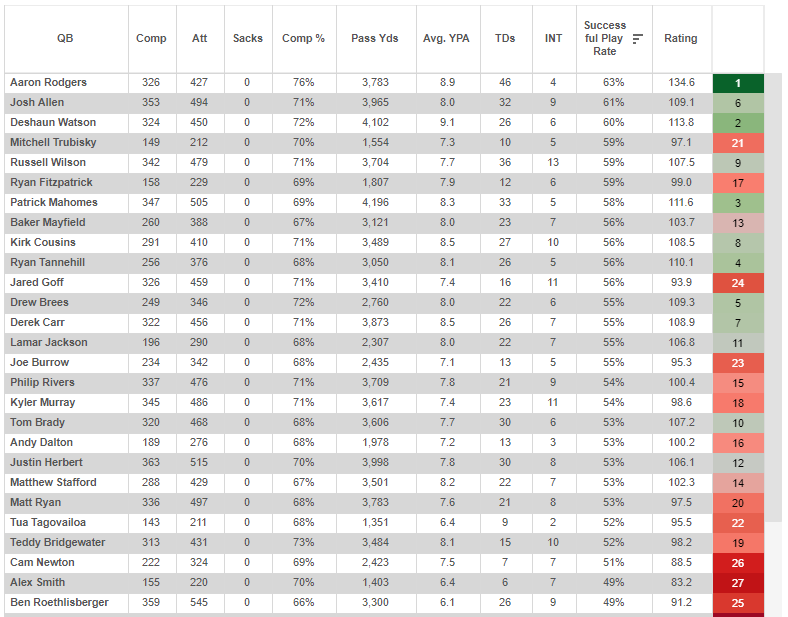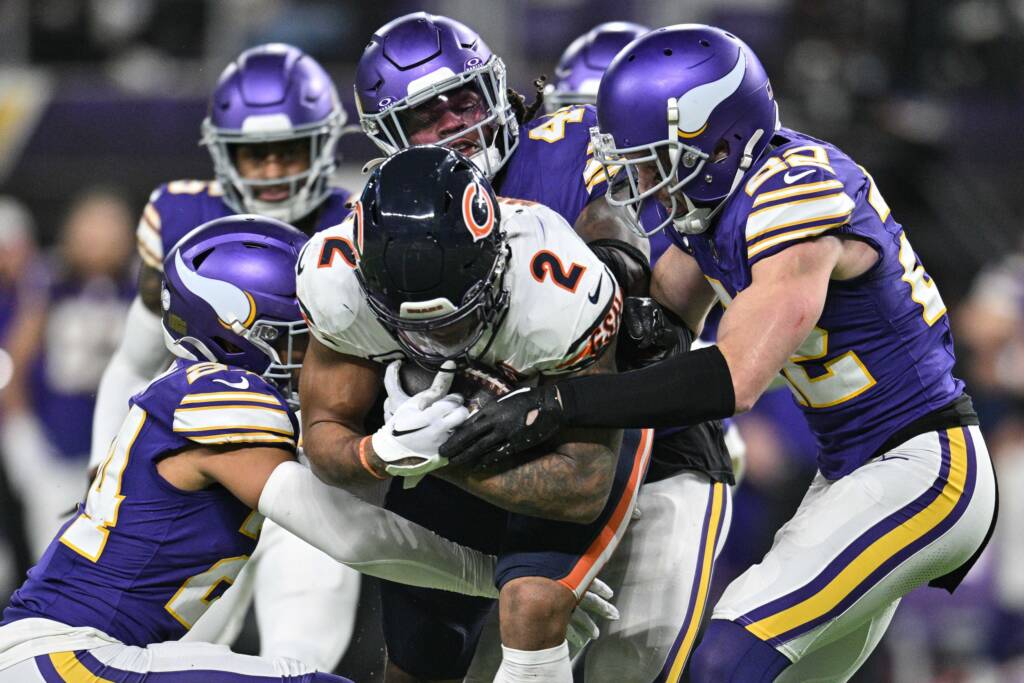The rollercoaster 2020 season is finally over. Unfortunately, with the Minnesota Vikings narrowly missing out on the playoffs with a 7-9 record that means it is time to talk about Kirk Cousins. Again.
It’s easy to look at Cousins’ contract and look at the team’s record and get infuriatingly mad. Signing Cousins was a contested issue at the time and seasons like 2020 (and 2018, really) prove why that contention was warranted. The full story on Minnesota’s season boils down to more than Cousins, though. Cousins himself was as culpable for the team’s struggles, of course, and the Vikings were culpable for not surrounding him with the team they believed they could when they signed him.
Let’s set the stage for what a Cousins team is supposed to look like in Minnesota. When the Vikings paid him, the idea seemed to be that Cousins was an above-average quarterback who would be good enough at steering the ship to generate a top-eight-ish offense while the defense took control of games. For the most part, Cousins held up his end of the bargain. He had his fair share of horrific games, like the Indianapolis Colts game in Week 2, but he was exactly who the Vikings thought he was.
The rest of the team was not.
The easiest place to start is the defense. A stout defense is supposed to accentuate the under-center, run-heavy approach the Vikings offense subscribes to. It’s a ball-control style of complementary football. When the defense falls from the regular top-10 level down to the bottom-five, well, that formula falls apart quickly. Games were getting away from the Vikings early and their offense was not really built to play that way. The earlier the offense has to deviate from what it wants to do, the more stress it puts on Cousins. It’s not supposed to be a shootout offense, even if it looked like it at times.
Minnesota’s special teams were also horrendous. Kicking, punting, kickoff coverage — all of it. The Vikings finished 31st in special teams DVOA, per Football Outsiders. They only placed higher than the Los Angeles Chargers. If the all-time catastrophe that is the Chargers special team unit is the only one worse than yours, you know you’ve got an awful special teams unit.
Between the poor defense and special teams combined, Minnesota’s offense faced the worst average starting field position in the league. Per Football Outsiders, their average drive started at the 25.49-yard line. The best way to think about this is not that every Minnesota drive started on the 25-yard line. Rather, the reason their average starting position is not higher is that the defense failed to get stops and turnovers, while the kick and punt units regularly allowed bigger returns than they should have, which in turn gave opposing teams better punt positions in the event the defense did make a stop. It’s a miracle the Vikings had a top 10 offense despite rarely getting opportune field position.
Despite some of the hardships the non-offense parts of the team put on Cousins, the $30 million man was still basically what he’s always been. Cousins finished 10th in adjusted net yards per attempt (ANY/A), ninth in Football Outsiders’ passing DYAR, and fourth in Next Gen Stats’ completion percentage over expected. He was completing a lot of passes and maintaining a fairly respectable offense. ESPN’s QBR saw Cousins less favorably, ranking him at 18th, but seeing as QBR does a better job weighing rushing contributions than other statistics, that probably makes sense.
There will be those who make the argument that Cousins’ stats were inflated by garbage time. If you sat through all 16 games, it’s hard to not come to that conclusion. The Vikings were regularly behind in games all year and Cousins did indeed have a couple garbage time stat-fillers (look no further than the Atlanta Falcons game). However, the numbers do not fully reveal that Cousins was a worse QB when the game was still alive.
It’s true, Cousins led the league in success rate and passer rating in the fourth quarter this season (min. 80 fourth-quarter attempts). He certainly put up numbers there, whether the game was within reach or not. However, Cousins still played to about his normal standard if you look at just plays in which the game was in reach. With the scoring margin between 14 points in either direction, Cousins ranked ninth out of 31 QBs in success rate (min. 200 attempts). He also tied for third in yards per attempt, while finishing eighth in passer rating. Those numbers are surely not as impressive as his raw fourth-quarter numbers, but they fall right in line with the idea that Cousins is an above-average, though perhaps unspectacular, passer.
Now, none of that is to say Cousins is without fault. Being “who the Vikings thought he was” is still very much a flawed quarterback, even if he’s a capable one. He had his fair share of poor games and still put some restrictions on the offense that forced it to play the way it did. Iffy depth at wide receiver and horrific offensive line play also had a hand in the structure of the offense, but many of Cousins’ same old issues cropped up to put a cap on the offense, even if much of the rest of his skill set raises the floor of the offense.
For one, Cousins’ arm talent somewhat limited what routes could be relied on in the offense. Cousins’ ability to get juice on his throws toward the sideline was up and down all season. He throws a mean back shoulder fade ball, no doubt, but those are really more touch throws than they are throws that require the juice to beat a cornerback breaking on the ball.
The Jacksonville Jaguars game in Week 13 was a good example of that. Cousins had a couple of throws that were open enough by NFL standards, but he left ‘em behind the wide receiver.
[videopress fDjG9T9d] [videopress gqsN6I42]Credit to Cousins for standing in versus pressure on the second throw. He was genuinely good at that all year. Granted, Cousins did not always show the arm strength to throw comfortably under pressure (as you can see here), but he was more than willing to do it, which paid off a handful of times when he already had his target in mind. However, leaving out-breaking throws like this behind the wide receiver is asking to be picked off.
[videopress YAzKpUh8]In fact, Cousins was picked off in that exact fashion for his first interception of the year. With just under a minute left in the first half, the Vikings had a chance to drive down the field against the Green Bay Packers to kick a field goal. These time-constricted drives usually feature a ton of throws to the sideline in order to help stop the clock. On the first play of this drive (not shown), Cousins sailed a pass over the receiver’s head on a 15-yard out route, in part because some pressure disrupted him. On the second play, the interception shown above, Cousins leaves the ball well behind the receiver, putting it in prime position for a star cornerback like Jaire Alexander to snag it.
Cousins also failed to show much creativity when working through broken plays. Though he’s certainly a capable rollout and bootleg passer, Cousins is not one who wants to operate outside the pocket on broken plays. He does not actively seek out to do so, nor is he very good in the instances where he is forced to do it. This has long been the case with Cousins, but the more the NFL moves towards play-makers being the standard (Patrick Mahomes, Josh Allen, Deshaun Watson, Justin Herbert, and even Ryan Tannehill, etc.), the more Cousins’ inability to do so becomes a burden.
Offenses are being optimized better than ever before, and we have seen that with the Vikings’ explosiveness on offense, but even so, the QB has to be able to make plays every now and then. Cousins just does not really have that as a regular feature to his game and he never has. It’s part of the deal the Vikings knew when they signed him.
That issue can be displayed, in part, in how explosive the offense is on first down compared to third down. On first down this season, the Vikings held the most explosive passing offense in the league. Fourteen percent of their first-down passes went for explosive plays (15-plus yards), which makes sense seeing as how strong their play-action game was. It’s easier to call play-action on first down when defenses are expecting a run.
On third downs, however, the Vikings’ offense plummeted to 20th (7%) in explosive passing rate. Play-action is not nearly as common for third-down scenarios, while, on the other hand, defenses tend to bring more blitzes on third down. That often means quarterbacks have to think fast to get the ball out and force a tough throw, or bail to make a play. Cousins was not particularly useful in that regard, and even his best years in that area have only been a bit above average.
On a similar note, Cousins also looked to have issues whenever defenses had a good read on the Vikings’ offense. Granted, that will be true to some degree of any quarterback, but because Cousins has no playmaking mechanism, the offense can stall out very quickly if the play-calling is even a little lackluster. The game against the Falcons midway through the year was a perfect example of that.
In the end, the answer on Cousins’ 2020 season is the boring one: He is who we all thought he was. Cousins is accurate over the middle, generally sharp at getting through his first couple reads, and is a menace on play-action. At the same time, Cousins is not someone who has the skills to elevate an offense beyond what it is on the surface, in large part because he has very little capacity to salvage broken plays and does not have a high-end arm. Cousins also provides nothing as a runner to help unlock a new part of the offense. All of this is stuff we already knew about Cousins when he signed with the Vikings a few years ago.
Had the Vikings been a better team overall, especially on defense, Cousins played well enough to lead them to a 10-plus win season. Cousins-led teams often require every ideal condition to be met in order to reach those double-digit win seasons, though, and there is no certainty that the Vikings will meet all those conditions next season. As always, Cousins will not make a team any worse than it is, but he is not going to be the one to carry the extra burden to make a team any better than it is on paper, either.


